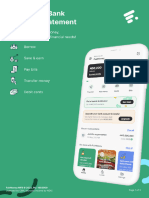0% found this document useful (0 votes)
24 views7 pagesBlockchain Tech Unit 2
The document provides an overview of blockchain technology, highlighting its key features such as decentralization, transparency, and security. It discusses the pros and cons of cryptocurrencies, particularly Bitcoin, and outlines various types of blockchains and their use cases. Additionally, it covers Bitcoin mining, its functionality, and the evolution of blockchain technology through a timeline of significant events.
Uploaded by
gadvedeatmalhargad1Copyright
© © All Rights Reserved
We take content rights seriously. If you suspect this is your content, claim it here.
Available Formats
Download as PDF, TXT or read online on Scribd
0% found this document useful (0 votes)
24 views7 pagesBlockchain Tech Unit 2
The document provides an overview of blockchain technology, highlighting its key features such as decentralization, transparency, and security. It discusses the pros and cons of cryptocurrencies, particularly Bitcoin, and outlines various types of blockchains and their use cases. Additionally, it covers Bitcoin mining, its functionality, and the evolution of blockchain technology through a timeline of significant events.
Uploaded by
gadvedeatmalhargad1Copyright
© © All Rights Reserved
We take content rights seriously. If you suspect this is your content, claim it here.
Available Formats
Download as PDF, TXT or read online on Scribd
/ 7























































































